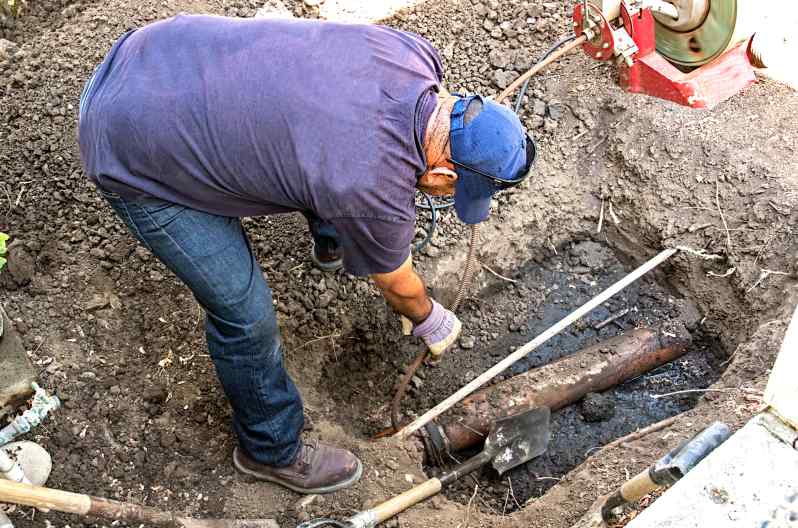One of the worst things you can experience as a homeowner is a sewer line backup. A sewage backup occurs when an obstruction or damage prevents wastewater from draining away from your house. This usually happens in the main sewer line that connects your home to the municipal sanitary sewers, but it could happen elsewhere as well. Due to the obstruction, wastewater will continue to fill your sewer lines and drain pipes, eventually causing a sewer backup in your house.
What Causes a Sewer Backup
Sewage backups are caused when wastewater cannot flow away from your home. As a result, it builds up in your drain pipes and eventually backs up into your house.
Clogged Sewer Lines
We tend to take our drains for granted and treat them like a garbage can. However, putting the wrong things down your drain will cause a clog and eventually lead to a sewer line backup. The worst things to put down your drains are fats, food waste, hair, and flushable wipes.
Tree Roots Growing in Sewer Lines
Tree roots can cause major problems if they grow into or through your sewer lines. Since roots can travel far from trees, they can cause a sewage backup even if you don’t have trees on your property. Once they grow into your sewer lines, the only way to fix the problem is to cut out the roots and then repair or replace the sewer pipe.
Cracked or Collapsed Sewer Lines
Depending on the age of your home, your sewer line could be made of PVC, clay, or Orangeburg. While they are all durable, they do not last forever. While PVC pipe will last as long as 100 years, clay and Orangeburg only last between 30 and 60 years. Sewer pipes can also crack unexpectedly as well.
Gutters, Downspouts, and Sump Pumps Routed into Sewers
While you can connect gutters, downspouts and sump pumps to your storm sewers, it is risky or even illegal to hook them up to your sanitary sewer line. Your sewer lines are only meant to remove wastewater from your house. Rainwater and snowmelt will overwhelm your sewer line and can cause a backup.
Problems with City Sewers
While you have some control over the causes above, there is very little you can do to prevent a city sewer backup. City sewers face the same problems as your own sewer lines. They can get clogged as well as wear out over time. Determining whether the problem is with your sewer line or the city sewers isn’t always easy. Typically clogged city sewers will affect several houses on your street, but that isn’t always the case.
What Are the Signs of a Possible Sewer Line Backup?
There are a few signs that could lead to sewage backup in your home. While just one is cause for concern, you should check your sewer line if you have two or more of the following:
- Several drains are clogged, drain very slowly, or are backing up
- Your drains smell bad, especially when you run water in other rooms
- Water gurgles in the sink when you flush the toilet or use the shower
- Your yard is soggy or smelly
How to Prevent a Sewage Backup in Your Home
The best way to prevent a sewer backup is to use your drains correctly. Also, you should have your sewer lines cleaned and inspected every five to ten years to prevent clogs. Not only will this limit damage, but it will keep the cost of sewage cleanup down if there is a backup. If you do have a sewer line backup, begin cleaning up raw sewage right away.
Tips for Preventing a Sewer Backup
- Never pour fats, oils, celery, or coffee grounds down the drain, even if you have a garbage disposal
- Avoid putting so-called flushable bathroom wipes in the toilet
- Never flush disposable diapers or hygiene products down the toilet
- Use a hair catcher in showers and bathtubs
- Never hook up gutters or downspouts to sanitary sewers
- Have your sewer line cleared every three to five years to remove clogs and build-up
- Have your sewer line inspected every six to ten years to check for cracks and wear
- Install floating backflow drain plugs in open floor drains
If you have had several sewage backups before, you may want to install either a backwater valve or an overhead sewer system as well. They are most effective if your backups are caused by problems with your city sewers.
A backwater valve prevents sewage from flowing backward into your home. Although less expensive to install, it does need yearly maintenance. Since it’s installed underground, it means digging up your yard every year.
An overhead sewer system stores wastewater in a well and slowly pumps it out to the street. While it offers much better protection against a sewer line backup, it costs more to install.
If you’ve had a sewer backup, our restoration specialists are available for round-the-clock cleanup and repair. Call 1-855-718-2903 now for a risk-free estimate on sewage backup cleanup services.






I wanted to thank you for explaining what could cause sewer backups. I didn’t know that a sewer pipe could be clogged if the toilets and rains aren’t cleaned and used as intended. It seems important to take time every now and then to thoroughly clean these areas.